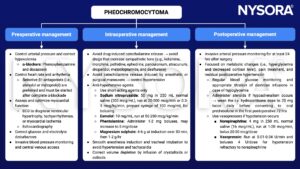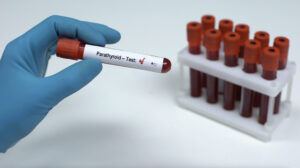Learning objectives
- Describe pheochromocytoma
- Recognize the symptoms and signs of pheochromocytoma
- Anesthetic management of a patient with a pheochromocytoma
Definition and mechanisms
- Pheochromocytomas are neuroendocrine tumors arising from chromaffin cells in the adrenal medulla
- Pheochromocytomas synthesize and secrete catecholamines (i.e., dopamine, norepinephrine, and epinephrine)
- The clinical presentation depends on the profile of the catecholamine secretion
- Norepinephrine: Hypertension
- Epinephrine: Tachycardia and tachydysrhythmias
- Neuroendocrine chromaffin tumors arising outside of the adrenal medulla are called paragangliomas
Signs and symptoms
- Hypertension
- Headache
- Heavy sweating
- Tachycardia
- Tachydysrhythmias
- Tremors
- Pallor
- Shortness of breath
- Panic attack-type symptoms
- Hyperglycemia
- Intravascular volume depletion (hypovolemia)
- Abdominal pain
Less common symptoms
- Anxiety
- Weight loss
- Blurred vision
- Constipation
Risk factors
- Family history of pheochromocytoma
- Family history of related genetic disorders
- Multiple endocrine neoplasia, type 2 (MEN 2)
- Von Hippel-Lindau disease
- Neurofibromatosis 1
- Hereditary paraganglioma syndromes
Complications
Hypertension can damage other organs, particularly the cardiovascular system, brain, and kidneys. This damage may result in the following critical conditions:
- Cardiovascular disease
- Stroke
- Kidney failure
- Problems with the nerves of the eye
Treatment
- Primary treatment: Surgery to remove the tumor
Management

Suggested reading
- Connor D, Boumphrey S. Perioperative care of phaeochromocytoma. BJA Education. 2016;16(5):153-158.
- Domi R, Sula H. Pheochromocytoma, the Challenge to Anesthesiologists. Journal Of Endocrinology And Metabolism. 2011;1(3):97-100.
We would love to hear from you. If you should detect any errors, email us customerservice@nysora.com







